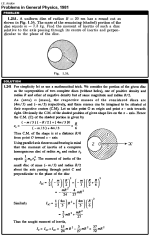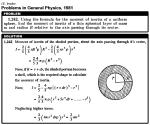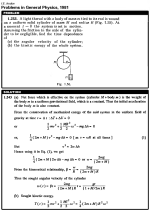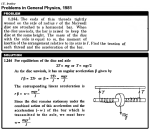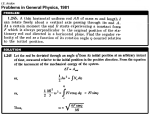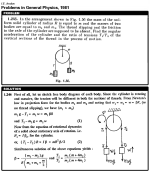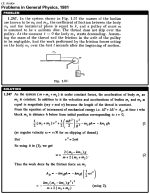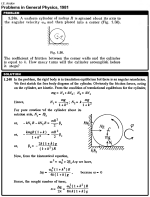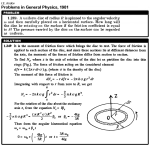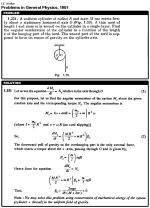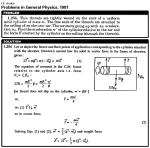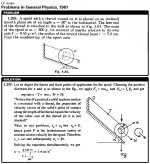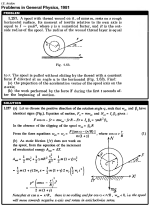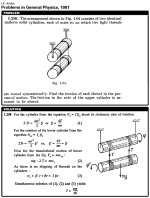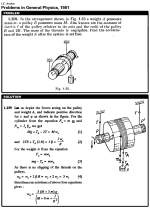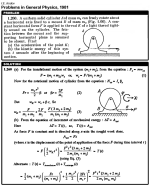| № |
Condition |
free/or 0.5$ |
| 241 | A uniform disc of radius R = 20 cm has a round cut as shown in Fig. 1.54. The mass of the remaining (shaded) portion of the disc equals m = 7.3 kg. Find the moment of inertia of such a disc relative to the axis passing through its centre of inertia and perpendicular to the plane of the disc. |
|
| 242 | Using the formula for the moment of inertia of a uniform sphere, find the moment of inertia of a thin spherical layer of mass m and radius R relative to the axis passing through its centre. |
|
| 243 | A light thread with a body of mass m tied to its end is wound on a uniform solid cylinder of mass M and radius R (Fig. 1.55). At a moment t = 0 the system is set in motion. Assuming the friction in the axle of the cylinder to be negligible, find the time dependence of (a) the angular velocity of the cylinder; (b) the kinetic energy of the whole system. |
|
| 244 | The ends of thin threads tightly wound on the axle of radius r of the Maxwell disc are attached to a horizontal bar. When the disc unwinds, the bar is raised to keep the disc at the same height. The mass bf the disc with the axle is equal to m, the moment of inertia of the arrangement relative to its axis is I. Find the tension of each thread and the acceleration of the bar. |
|
| 245 | A thin horizontal uniform rod AB of mass m and length l can rotate freely about a vertical axis passing through its end A. At a certain moment the end B starts experiencing a constant force F which is always perpendicular to the original position of the stationary rod and directed in a horizontal plane. Find the angular velocity of the rod as a function of its rotation angle φ counted relative to the initial position. |
|
| 246 | In the arrangement shown in Fig. 1.56 the mass of the uniform solid cylinder of radius R is equal to m and the masses of two bodies are equal to m1 and m2. The thread slipping and the friction in the axle of the cylinder are supposed to be absent. Find the angular acceleration of the cylinder and the ratio of tensions T1/T2 of the vertical sections of the thread in the process of motion. |
|
| 247 | In the system shown in Fig. 1.57 the masses of the bodies are known to be m1 and m2, the coefficient of friction between the body m1 and the horizontal plane is equal to k, and a pulley of mass m is assumed to be a uniform disc. The thread does not slip over the pulley. At the moment t = 0 the body m2 starts descending. Assuming the mass of the thread and the friction in the axle of the pulley to be negligible, find the work performed by the friction forces acting on the body m1 over the first t seconds after the beginning of motion. |
|
| 248 | A uniform cylinder of radius R is spinned about its axis to the angular velocity ω0 and then placed into a corner (Fig. 1.58). The coefficient of friction between the corner walls and the cylinder is equal to k. How many turns will the cylinder accomplish before it stops? |
|
| 249 | A uniform disc of radius R is spinned to the angular velocity ω and then carefully placed on a horizontal surface. How long will the disc be rotating on the surface if the friction coefficient is equal to k? The pressure exerted by the disc on the surface can be regarded as uniform. |
|
| 250 | A flywheel with the initial angular velocity ω0 decelerates due to the forces whose moment relative to the axis is proportional to the square root of its angular velocity. Find the mean angular velocity of the flywheel averaged over the total deceleration time. |
|
| 251 | A uniform cylinder of radius R and mass M can rotate freely about a stationary horizontal axis 0 (Fig. 1.59). A thin cord of length L and mass m is wound on the cylinder in a single layer. Find the angular acceleration of the cylinder as a function of the length x of the hanging part of the cord. The wound part of the cord is supposed to have its centre of gravity on the cylinder axis. |
|
| 252 | A uniform sphere of mass m and radius R rolls without slipping down an inclined plane set at an angle α to the horizontal. Find: (a) the magnitudes of the friction coefficient at which slipping is absent; (b) the kinetic energy of the sphere t seconds after the beginning of motion. |
|
| 253 | A uniform cylinder of mass m = 8.0 kg and radius R = 1.3 cm (Fig. 1.60) starts descending at a moment t = 0 due to gravity. Neglecting the mass of the thread, find: (a) the tension of each thread and the angular acceleration of the cylinder; (b) the time dependence of the instantaneous power developed by the gravitational force. |
|
| 254 | Thin threads are tightly wound on the ends of a uniform solid cylinder of mass m. The free ends of the threads are attached to the ceiling of an elevator car. The car starts going up with an acceleration w0. Find the acceleration w' of the cylinder relative to the car and the force F exerted by the cylinder on the ceiling (through the threads). |
|
| 255 | A spool with a thread wound on it is placed on an inclined smooth plane set at an angle α = 30° to the horizontal. The free end of the thread is attached to the wall as shown in Fig. 1.61. The mass of the spool is m = 200 g, its moment of inertia relative to its own axis I = 0.45 g*m2, the radius of the wound thread layer r = 3.0 cm. Find the acceleration of the spool axis. |
|
| 256 | A uniform solid cylinder of mass m rests on two horizontal planks. A thread is wound on the cylinder. The hanging end of the thread is pulled vertically down with a constant force F (Fig. 1.62). Find the maximum magnitude of the force F which still does not bring about any sliding of the cylinder, if the coefficient of friction between the cylinder and the planks is equal to k. What is the acceleration wmax of the axis of the cylinder rolling down the inclined plane? |
|
| 257 | A spool with thread wound on it, of mass m, rests on a rough horizontal surface. Its moment of inertia relative to its own axis is equal to I = γmR2, where γ is a numerical factor, and R is the outside radius of the spool. The radius of the wound thread layer is equal to r. The spool is pulled without sliding by the thread with a constant force F directed at an angle α to the horizontal (Fig. 1.63). Find: (a) the projection of the acceleration vector of the spool axis on the x-axis; (b) the work performed by the force F during the first t seconds after the beginning of motion. |
|
| 258 | The arrangement shown in Fig. 1.64 consists of two identical uniform solid cylinders, each of mass m, on which two light threads are wound symmetrically. Find the tension of each thread in the process of motion. The friction in the axle of the upper cylinder is assumed to be absent. |
|
| 259 | In the arrangement shown in Fig. 1.65 a weight A possesses mass m, a pulley B possesses mass M. Also known are the moment of inertia I of the pulley relative to its axis and the radii of the pulley R and 2R. The mass of the threads is negligible. Find the acceleration of the weight A after the system is set free. |
|
| 260 | A uniform solid cylinder A of mass m1 can freely rotate about a horizontal axis fixed to a mount B of mass m2 (Fig. 1.66). A constant horizontal force F is applied to the end K of a light thread tightly wound on the cylinder. The friction between the mount and the supporting horizontal plane is assumed to be absent. Find: (a) the acceleration of the point K; (b) the kinetic energy of this system t seconds after the beginning of motion. |
|
